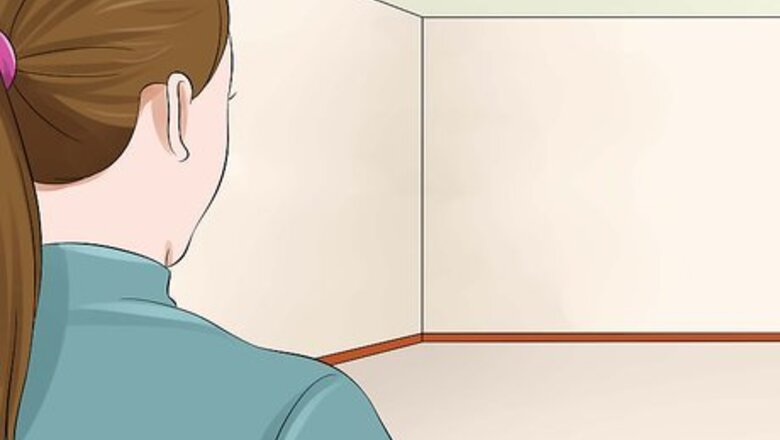
views
Starting With a Single Room

Designate one room as the cat room. This room will not always be the cat's room, but confining it to one place for a day or longer can make the cat feel safer. Then, once the cat ventures out, it can consider that its home base to return to, which will also make it feel more secure. If you let the cat roam free, it can seem like too much at first. Giving it one room gives it a chance to thoroughly explore that space before moving on to another.

Add a litter box. This home base will need a place for your cat to use the restroom. Make sure to include a litter box with litter inside it. When you first bring your cat in, open the crate near the litter box so it knows where it is.
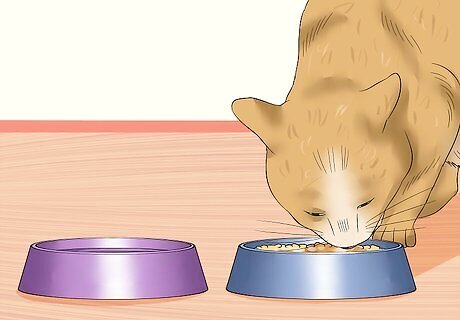
Put in food and water. Of course, the cat will need to eat and drink, so it needs ot be in the same room with the litter box. However, try to separate the two, as most cats don't like to eat in the same place they go to the bathroom. Try putting the litter box and food on opposite sides of the room. In addition to being preferable for you cat, it forces it to explore the whole room.

Add some toys. Toys are always a good way to keep a cat entertained, especially if it's not ready to play with you quite yet. Jingly balls, scrunchy balls, and mice are all good toys for cats to play with, though you may want to keep any string-type toys for use when you can supervise.
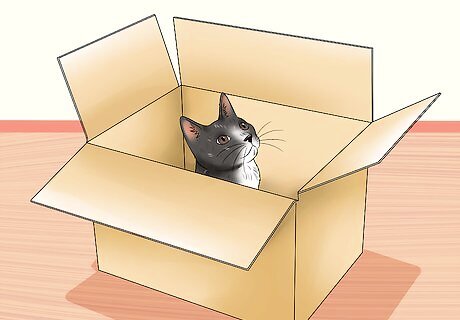
Make sure there's a hiding place. Many cats feel the need to hide away when they first get to a new place. Hiding gives them time to adjust, and it makes them feel safer. Therefore, make sure the room you choose has appropriate hiding places. For example, a cat tunnel or a cardboard box makes a good hiding place. Underneath beds (as long as it's free from debris and dirt) is a good place, as is the closet.

Don't forget a place to sleep. You've placed some beds around your house, but don't forget to add one to your cat's room, too. It will want a place to curl up, though it will probably make its own place even if you don't provide one. A blanket or towel in a cardboard box is great for the first few days. It provides a bed, and it gives the cat a place to hide away if it wants.
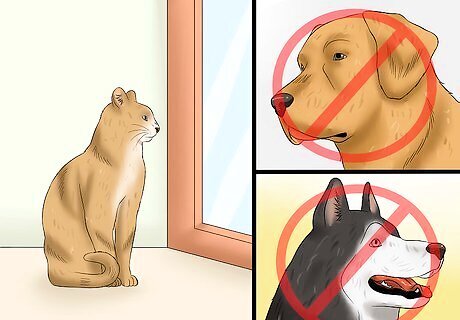
Keep other pets out. Another purpose of giving your new cat its own space is to slowly introduce the cat to your other pets, if you have them. In that vein, it's a good idea to keep them out of the new cat's room for the first day or two. They can get to know each other's scents through the door, giving them time to start adjusting.
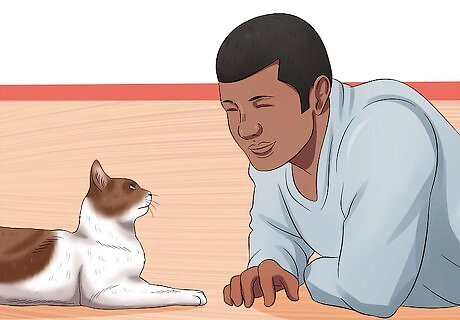
Don't just abandon the cat. The cat room is the place where you will get to know your cat. After the cat has had a few hours in the room, go inside and sit down. Talk soothingly the whole time, and don't make any sudden movements. You may need to do this several times over several days before the cat approaches. Let the cat come to you. Don't try to drag it out for cuddles. If the cat approaches, let it smell you. You can also try to gently pet it, but it may run away. Remember that each person in the house will need to spend time getting to know the cat. You can also try playing with the cat to help it get to know you by waving a string toy around so it wants to come play.
Getting Your House Ready

Look for strangle hazards. Cats are notoriously curious, and they will play with anything they can find. Look around your rooms to see what could pose a potential strangling hazard, such as the cords on blinds. Try cutting the cords at the bottom or undoing the knot so they aren't looped anymore. Some companies are making strangle-free blinds now, as it also poses a hazard to children. Long drapes and tassels can become strangulation hazards, as can vertical blinds, if your cat catches its neck between slats.
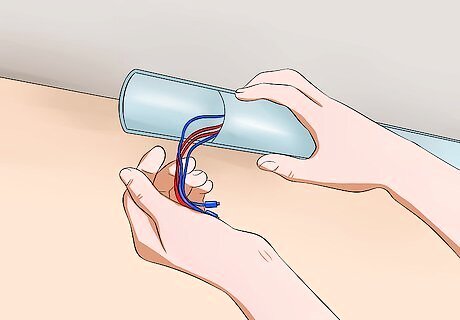
Check for other physical hazards. Dangling cords, knickknacks, rubber bands, paper clips, and other small items can all be hazardous to cats and kittens. Consider moving cords out of reach or covering them in plastic tubing. Make sure to put things like rubber bands and paper clips into drawers or jars where your cat can't get them. Knickknacks are harder. You can put them on higher shelves, but cats are great jumpers. You may need to put some knickknacks behind glass.
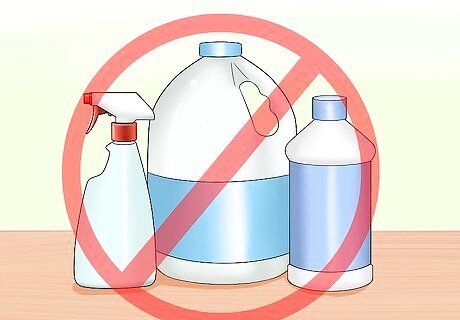
Hide the chemicals. Many household chemicals are toxic to cats. Think cleaners, pesticides, and car fluids, to name a few. Place all chemicals in cabinets where kitty won't be tempted to lick or drink them. Some chemicals, including some car fluids, taste sweet, which is why kitty may be tempted to lick them. Another option is to keep them in places where your cat's not allowed, such as the garage.

Remove toxic plants. Many common household plants are toxic to cats. You would think that your cat would know which plants not to eat, but cats are curious and will often nibble on any plant they find. Some common toxic plants include (but is certainly not limited to) aloe, lilies, baby's breath, irises, and ivy. Move these plants to high ground or hang them from the ceiling. Also, be careful of falling leaves, as even those can be toxic. You can also move them to a room the cat doesn't go in or outside.
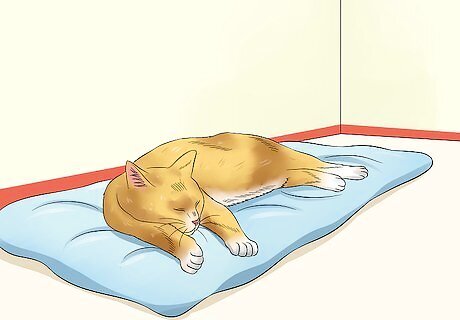
Make beds for your cat. It's pretty hard to keep pets off furniture, if that's your goal, but one way to help is to give your cat its own special beds. Even if you don't expect your cat to stay off the furniture, giving your cat its own bed can make it feel more comfortable. If you're trying to get the cat to stay off furniture, you'll need a bed in every room. It doesn't need to be a fancy cat bed. Even a nice, flat pillow will work or folded up blanket. Consider putting them in spots cats will like, such as on window sills or in high-up places.
Getting Everything You Need

Get a collar and ID tag. An ID tag is important because it helps people return your cat to you should it ever run away. The ID tag should have the cat's name on it, if you've decided already, as well as some contact information for you, such as a phone number. Most pet stores have machines for making tags. Choose a breakaway collar, which will come apart if your cat gets it snagged on something. Your cat will lose the ID, but it won't be strangled by the collar. Another option is a harness. A harness has a loop that goes around the neck and one that goes around the cat under the first set of legs. The two loops are attached by at least one strap down the back, though having a strap on the chest is a good idea, too. Harnesses are good because it's less likely your cat will be strangled by them, plus they're harder to wiggle out of. Consider microchipping. A microchip is a small (think a grain of rice) chip placed under your cat's skin. If your cat is taken to a shelter or vet's, your cat's microchip can be scanned to find out your contact information.

Get food, water, and litter, plus containers. You'll need a container each for food and water. Stainless steel, ceramic, and glass are easiest to clean. You'll also need a litter box and litter. Ask the shelter where you get your kitten or cat what kind of food your using, as it's good to at least start them on the same food. Some cats don't like bowls that are too deep or narrow, especially if it constricts their whiskers. Consider a fairly small, shallow bowl, at least at first. If you know what litter the cat has previously used, it can help to use the same kind of litter in its new box. Some cats can be finicky about litter and litter boxes, so you may need to try several different kinds before figuring out what your cat likes.

Think about your cat's entertainment and scratching needs. Toys help keep your cat entertained. In addition, they can provide distraction from destroying other items in your home. Make sure you have toys on hand, such as jingly toys and even string toys or ones with feathers. In addition, you may want a scratching post for your cat to sharpen its claws on, rather than your furniture. The best scratching posts are sturdy and somewhat tall. It should be at least long enough for the cat to stretch out full length and sharpen its claws because cats often stretch out for the process.
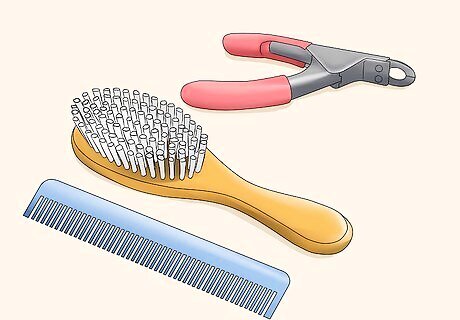
Don't forget the grooming tools. You'll of course need a brush for your cat. Most cats require regular brushing, though how often depends on the type of cat you have. You'll also need clippers to trim the cat's nails. A pair of pet claw trimmers works best for this purpose, which you can find at a pet store.

Have a carrier ready. You want to be ready to bring your pet home, and that means you need something to carry it in. The best option is a pet carrier. The sturdy, hard-sided plastic kind hold up longer, but the soft-sided kind will work. Make sure that it has good ventilation. A hard-sided kind will also keep your cat safer in the car. The best place to put the carrier is behind the driver's or passenger's seat on the floor, if it will fit.

Have a cat book on hand. If you've never had a cat before, you may want to get a book on owning cats so you understand the basics. If you don't want to buy one, consider checking one out form your local library.

Find a vet. Sometimes, things happen, and your cat will get sick. When you do, it's a good idea to already have a vet, so you have a place to take it. Ask your friends with pets if they have any recommendations for vets. It's also a good idea to meet with the vet to see if you feel comfortable with him or her. In addition, you'll want to get your cat vaccinated if its not already, so having one in place is a good idea when you bring your cat home. Don't forget, you'll also want to get your cat spayed or neutered if it's not already.



















Comments
0 comment